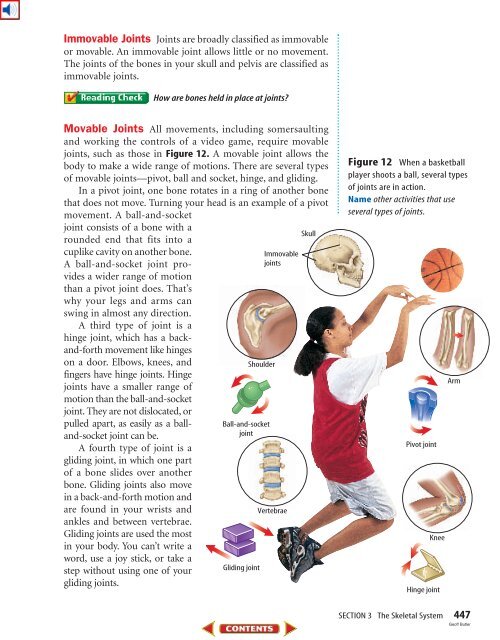Chapter 15: Support, Movement, and Responses - Science
Chapter 15: Support, Movement, and Responses - Science
Chapter 15: Support, Movement, and Responses - Science
Create successful ePaper yourself
Turn your PDF publications into a flip-book with our unique Google optimized e-Paper software.
Immovable Joints Joints are broadly classified as immovable<br />
or movable. An immovable joint allows little or no movement.<br />
The joints of the bones in your skull <strong>and</strong> pelvis are classified as<br />
immovable joints.<br />
How are bones held in place at joints?<br />
Movable Joints All movements, including somersaulting<br />
<strong>and</strong> working the controls of a video game, require movable<br />
joints, such as those in Figure 12. A movable joint allows the<br />
body to make a wide range of motions. There are several types<br />
of movable joints—pivot, ball <strong>and</strong> socket, hinge, <strong>and</strong> gliding.<br />
In a pivot joint, one bone rotates in a ring of another bone<br />
that does not move. Turning your head is an example of a pivot<br />
movement. A ball-<strong>and</strong>-socket<br />
joint consists of a bone with a<br />
rounded end that fits into a<br />
cuplike cavity on another bone.<br />
A ball-<strong>and</strong>-socket joint provides<br />
a wider range of motion<br />
than a pivot joint does. That’s<br />
why your legs <strong>and</strong> arms can<br />
swing in almost any direction.<br />
A third type of joint is a<br />
hinge joint, which has a back<strong>and</strong>-forth<br />
movement like hinges<br />
on a door. Elbows, knees, <strong>and</strong><br />
fingers have hinge joints. Hinge<br />
joints have a smaller range of<br />
motion than the ball-<strong>and</strong>-socket<br />
joint. They are not dislocated, or<br />
pulled apart, as easily as a ball<strong>and</strong>-socket<br />
joint can be.<br />
A fourth type of joint is a<br />
gliding joint, in which one part<br />
of a bone slides over another<br />
bone. Gliding joints also move<br />
in a back-<strong>and</strong>-forth motion <strong>and</strong><br />
are found in your wrists <strong>and</strong><br />
ankles <strong>and</strong> between vertebrae.<br />
Gliding joints are used the most<br />
in your body. You can’t write a<br />
word, use a joy stick, or take a<br />
step without using one of your<br />
gliding joints.<br />
Gliding joint<br />
Shoulder<br />
Ball-<strong>and</strong>-socket<br />
joint<br />
Immovable<br />
joints<br />
Vertebrae<br />
Skull<br />
Figure 12 When a basketball<br />
player shoots a ball, several types<br />
of joints are in action.<br />
Name other activities that use<br />
several types of joints.<br />
Pivot joint<br />
Knee<br />
Hinge joint<br />
Arm<br />
SECTION 3 The Skeletal System 447<br />
Geoff Butler
















